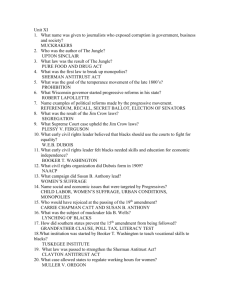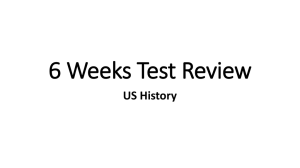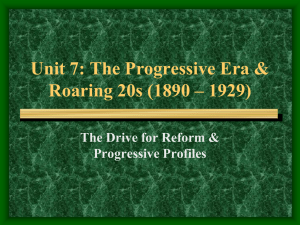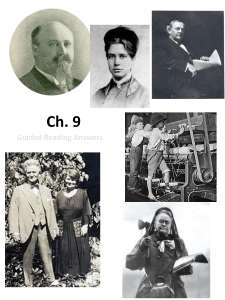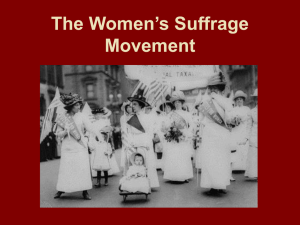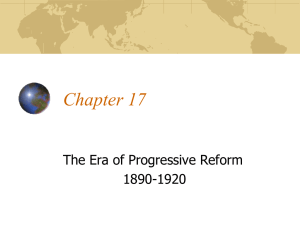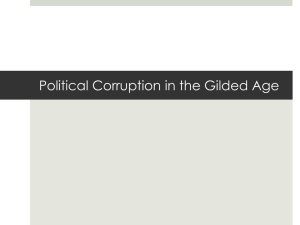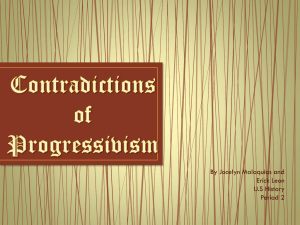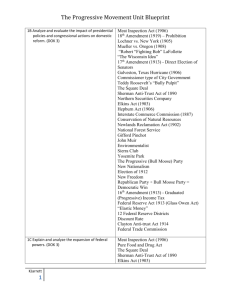Progressivism and the Age of Reform
advertisement
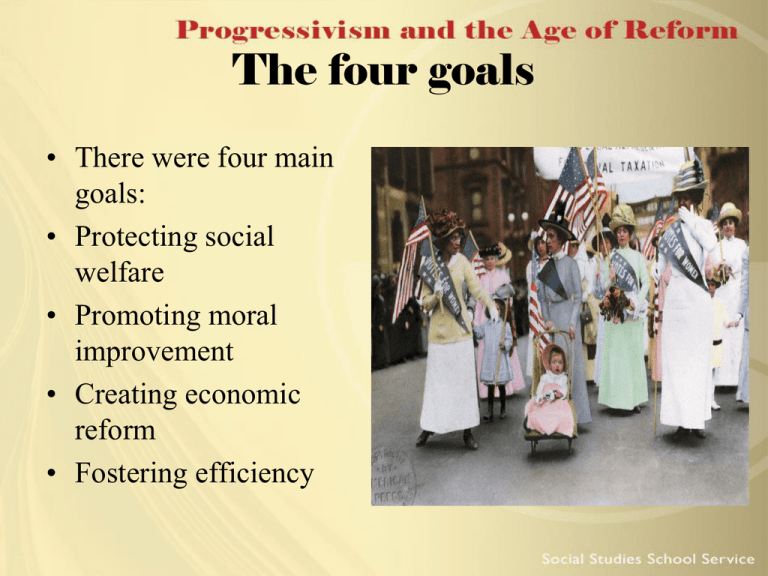
The four goals • There were four main goals: • Protecting social welfare • Promoting moral improvement • Creating economic reform • Fostering efficiency Promoting Moral Improvement • Many believed that morality held the key to improving the lives of poor people. This included personal behavior, in particular Prohibition. The Woman’s Christian Temperance Union spearheaded the crusade. Women and Progressive Reforms • Women became much more involved in social and political causes • Mainly middle- and upper-class women • Aimed to increase “moral behavior” of lower classes • Organizations such as YWCA and National Consumers League A YWCA poster WCTU Members advanced their cause by entering saloons, singing, praying, and urging saloon keepers to stop selling alcohol. At one time they had 245,000 members. Carry Nation worked for this group and walked into saloons scolding the customers, and using her hatchet to destroy bottles of liquor. Protecting Working Children • Reformers worked to protect children and end child labor. Many families had their children work because they needed the money. In 1904 the National Child Labor Committee sent investigators to gather evidence of working conditions for children. They organized exhibits to show the harsh conditions children worked under. This led to legislation in nearly every state to ban child labor. Other Improvements • During the Progressive era, public health officers launched successful campaigns against hookworm, malaria, and pellagra, and reduced the incidence of tuberculosis, typhoid and diphtheria. Pure milk campaigns also slashed rates of infant and child mortality. Food and Drug Legislation • In response to growing public outrage over unsafe and unsanitary food • Upton Sinclair’s The Jungle • Meat Inspection Act (1906) • Pure Food and Drug Act (1906) A German meatpacking plant Child Labor Child coal miners • 1.75 million under 16 had jobs in 1900 (not including farms) • Progressives campaigned against child labor and for higher adult wages • “Mother” Jones and the Children’s Crusade Child Labor (continued) • National Child Labor Committee (1904) • Hine’s photographs • Child labor laws in Northern states • U.S. Children’s Bureau • Fair Labor Standards Act of 1938 Famous photograph by Lewis Hine of a girl working in a textile factory Women’s Suffrage • Included in movement toward more democratic government • NAWSA formed in 1890 • More women served as progressive leaders • Anthony, Catt, and Paul • 19th Amendment passed in 1919 Suffragists celebrate the ratification of the 19th Amendment Women’s Suffrage Movement • Women worked, took care of the home and were not given the right to vote. 1872 Susan B. Anthony is arrested in Rochester, New York, for attempting to vote. At the same time, Sojourner Truth appears at a polling booth in Grand Rapids, Michigan, demanding a ballot; she is turned away. A Woman Suffrage Amendment is introduced in the United States Congress. The wording is unchanged in 1919, when the amendment finally passes both houses. In 1890: NWSA and the AWSA are reunited as the National American Woman Suffrage Association (NAWSA) under the leadership of Elizabeth Cady Stanton. The settlement house movement and the Progressive campaign during this time propelled thousands of college-educated white women and a number of women of color into lifetime careers in social work. It also made women an important voice to be reckoned with in American. 1912 Theodore Roosevelt's Progressive Party becomes the first national political party to support suffrage for women. In 1913 Alice Paul and Lucy Burns organize a major suffrage parade in Washington, D.C. with over 5,000 women attending. The mistreatment of the marchers by the crowd and the police led to a great public outcry and the event was a media coup for the suffragists. This is seen in the movie Iron Jawed Angels. 1918-1920 The Great War (World War I) intervenes to slow down the suffrage campaign as some--but not all-suffragists decide to shelve their suffrage activism in favor of "war work." Alice Paul and the NWP stage daily pickets and many women are arrested at the White House. Many saw the contribution women made to society during the war and therefore on August 26, 1920 the Nineteenth Amendment was ratified. Its victory accomplished, NAWSA ceases to exist, but its organization becomes the nucleus of the League of Women Voters. The Temperance Movement • Some felt that alcohol undermined society’s “moral fabric” • Supported curtailing or banning alcohol • WCTU and Anti-Saloon League • Targeted immigrants and corrupt politicians • State and local successes • 19th Amendment (1919) The Eugenics Movement • Believed that those with “inferior” genes threatened the nation’s future • Sought to curb reproduction by the “inferior” and increase reproduction by the “superior” • Supported by many Progressives • 18 states enacted eugenics laws • Waned after WWII President Theodore Roosevelt • Considered a liability by Republican Party leaders • Disliked both excessive corporate power and potential violence by the working class • Believed the wealthy had a moral obligation to help the poor President Theodore Roosevelt (continued) • Increased federal government’s role in regulation • Only opposed monopolies he believed worked against the public interest • Became very popular Roosevelt: The Square Deal • A package of laws and regulations that he felt to be fair to all, particularly workers: – Increased regulation of business – Workers’ right to organize – Eight-hour work days – Pure food and drug laws – Income and inheritance taxes on the wealthy Roosevelt: Trustbusting • Established Department of Commerce and its Bureau of Corporations • Invoked Sherman Antitrust Act in over 40 lawsuits • Northern Securities Company case set precedent • Hepburn Act set maximum railroad rates and strengthened the ICC Roosevelt: Conservation Ethic and Actions Roosevelt and naturalist John Muir at Yosemite in California • Saw America’s landscape as central to its democratic spirit; natural resources vital to economic, political strength • Resources belong to the public • Set aside numerous public lands • U.S. Forest Service (1905) • Antiquities Act (1906) The Coal Strike of 1902 Striking miners • May: PA mine workers struck over wages and safety • Threatened coal availability • June: Roosevelt ordered investigation • October: Roosevelt’s meeting; no progress • Public support for strikers grew The Coal Strike of 1902 (continued) • Morgan’s commission • Strike ended late October • Increased union confidence and membership • Set precedent for federal involvement in strikes The Panic of 1907 • • • • • J.P. Morgan A severe economic crisis Recession began in 1906 NYSE plunged by 50 percent Runs on banks Knickerbocker Trust Company collapsed • Unemployment, bankruptcies rose; production, imports fell • J.P. Morgan, others personally contributed money The Federal Reserve Act • Response to Panic of 1907 • National Monetary Commission • Federal Reserve Act (1913) • Federal Reserve System • Gave government control over monetary and banking systems, in accordance with Progressive Era trends A painting depicting President Wilson signing the Federal Reserve Act The Progressive Party and the Election of 1912 • Taft won in 1908 • Rift in Republican Party between Progressives and conservatives • Progressive (“Bull Moose”) Party split from Republican Party; nominated Roosevelt • Democrat Wilson won in 1912, with Roosevelt second Progressive Party convention, 1912 The Progressive Era: Legacy • Wilson established FTC, progressive income tax; also passed Clayton Antitrust Act • Many reforms remain in place today • Did not radically change the structure of society • Set precedent for governmental protections against unchecked capitalism
